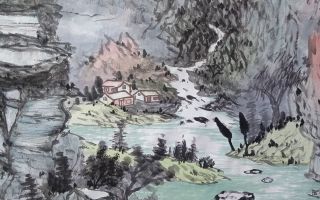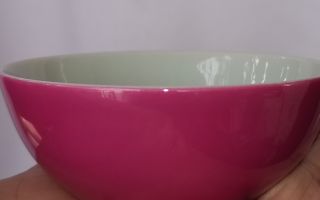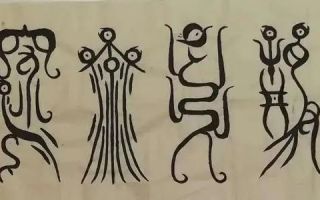艺术品中的意境和传神(神韵)

古代艺术品中的意境和传神(神韵)
Artistic conception and charm in ancient works of Art
意境和传神是中国美学史上有关艺术美的两个重要概念。
Artistic conception and vividness are two important concepts about artistic beauty in the history of Chinese aesthetics.
古代艺术品的审美,十分重要的两样东西~意境和传神(神韵)。
There are two important things in the aesthetic appreciation of ancient works of Art: artistic conception and charm.
意境其实就是一种心态和心智,这些都是我们平常对大自然的认识和理解。先说说心态,现在的社会太现实,现实得变成浮躁,短视,贪婪,无信,疑虑,无为,急功近利,不愿意探讨学习 ,坐下来看看书也懒,不求甚解,看看大标题就说可以了,我知道什么回事。这种心态,怎能潜心用心学习和观察?
Artistic conception is actually a kind of mentality and mind, which are our usual understanding of nature. Let's talk about the mentality first. The society is too realistic now. The reality has to be impetuous, short-sighted, greedy, dishonest, suspicious, inactive, eager for quick success and instant benefit, unwilling to discuss and study, lazy to sit down and read books, not seeking a good understanding. Just look at the headline and say, I know what's going on. How can we concentrate on learning and observing?
显然不可以!这样就会导致我们的心智不高,平平庸庸,什么是真?什么是假?什么才是真善美,大自然的一花一草一木一石头究竟是怎样的?山水石头是怎样的?农民伯伯是怎样插秧种田的?稻谷长得怎样的?可能是一无所知,古人云~美来源于生活和劳动。
Obviously not! This will lead to our mind is not high, mediocre, what is true? What is fake? What is true, good and beautiful? What is the nature of a flower, a plant, a stone? What is the landscape stone like? How does the farmer uncle plant rice seedlings? How does rice grow? The ancients said that beauty comes from life and labor.
传神~就是平常我们说古代艺术品上面所表现出来的神韵,它的具体信息是造型,彩料,画面上的画风,老旧,氧化反应后所现露出来的宝光等等。这些都会体现在宏观上和微观上面,有人说: 神韵很虚渺,我说: 不是的。
Vividness is the charm of ancient works of art. Its specific information is modeling, color materials, painting style on the screen, aging, Baoguang after oxidation reaction, etc. These will be reflected in the macro and micro, some people say: verve is very vague, I said: No.
关键就是你有没有弄懂,就是你能不能理解造型的比例,釉面上的所有氧化反应信息的东西。
The key is whether you understand, that is, whether you can understand the proportion of modeling, all the oxidation reaction information on the glaze.
这种鉴赏法绝不会是现在看美女的审美观,现在看的是臀大胸大。我的审美观不是这样子的。
This kind of appreciation will never be the aesthetic view of looking at beautiful women now. What we are looking at now is big hips and big breasts. That's not my aesthetic.
英姿飒爽,干练,静如鐘动如松,稳重 才是现代美,谢谢!
Valiant, capable, quiet as the clock, moving as loose, steady is the modern beauty, thank you!
大家可以翻翻书古代是怎样瞄述美女的。还有你开以翻翻中国古代的字画,就算你翻到唐代人,以肥为美的时候,人家也是珠园玉润的人,绝不会是现在。
You can turn to the book about how beauty was described in ancient times. In addition, you can turn to ancient Chinese calligraphy and painting. Even if you turn to the people of Tang Dynasty, when fat was the beauty, they were also the people of Zhuyuan Yurun, not now.
所谓,亭亭玉立,楚楚动人,沉鱼落雁,闭月羞花,是说美貌加以黛羞的脸貌。
The so-called, graceful, charming, sinking fish and wild geese, shy flowers, is to say beauty and Dai shy face.
当然,中国美学史上有关艺术美的概念并非只有这两个,例如妙语连珠、神彩奕奕等都是,但是,它们不像意境和传神抓住了艺术美的特征,对后世影响很大。一直到今天,我们谈艺术美的创造和欣赏时还是离不开意境与传神。
Of course, there are not only these two concepts about artistic beauty in the history of Chinese aesthetics, such as witty words and vivid colors. However, they do not capture the characteristics of artistic beauty like artistic conception and vividness, and have a great influence on later generations. Up to now, when we talk about the creation and appreciation of artistic beauty, we still cannot do without artistic conception and vividness.
意境一一情景交融
Artistic conception -- a blend of emotion and scenery
意境~是我国美学思想中的一个重要范畴,它体现了艺术美。在艺术创造、欣赏和批评中常常把“意境”作为衡量艺术美的一个标准。
Artistic conception is an important category in Chinese aesthetics, which embodies the beauty of art. In artistic creation, appreciation and criticism, "artistic conception" is often regarded as a standard to measure artistic beauty.
意境是客观(生活、景物)与主观(思想、感情)相熔铸的产物。
Artistic conception is the product of the fusion of objective (life, scenery) and subjective (thought, emotion).
意境是情与景、意与境的统一。
Artistic conception is the unity of feeling and scene, meaning and scene.
明代朱承爵在论诗时,曾说: 作诗之妙,全在意境融彻,出声音之外,乃得真味。清代王国维也曾说: 文学之事,其内足以摅己,外足以感人者,意与境二者而已。他们所提出的“境界”说,即意与境的统一。
When discussing poetry in the Ming Dynasty, Zhu chengjue once said that the beauty of poetry lies in the integration of artistic conception and sound, but in the true taste. Wang Guowei of the Qing Dynasty also said: the matter of literature, which is enough to be self-conscious inside and touching outside, is only about meaning and context. Their "realm" theory is the unity of meaning and realm.
意情和境景的关系也就是心与物的关系。意情属于主观范時,境景是客观范時。在意境中主观与客观的统一具体表现为情景交融。王夫之曾说: 情景名为二,而实不可离。神于诗者,妙合无垠。巧者则有情中景,景中情。又说:景中生情,情中含景。
The relationship between emotion and environment is the relationship between mind and object. The mood belongs to the subjective norm, and the scene belongs to the objective norm. In the artistic conception, the unity of subjectivity and objectivity is embodied in the blending of feelings and scenes. Wang Fuzhi once said: the name of the scene is two, but the reality is inseparable. God in poetry, wonderful and boundless. The skillful person has the sentiment in the scene, the scene in the sentiment. Also said: the scene of love, love contains the scene.
东晋画家王微也讲到山水画中主观与客观的关系,他说: 且古人之作画也,非以案城域,辨方州,标镇阜,划浸流,本乎形者融,灵而动变者心也。
Wang Wei, a painter of the Eastern Jin Dynasty, also talked about the relationship between the subjective and the objective in landscape painting. He said: the painting of the ancients was not based on the case of the city, the identification of Fangzhou, the marking of Zhenfu and the drawing of jinliu. It was based on the fusion of the form and the change of the spirit.
这是说,山水画所以区别于制作地图,在于它不是纯客观地去描绘自然,而是要体现画家的情思。所谓望秋云神飞扬,临春风思浩荡的情景。
That is to say, the difference between landscape painting and map making lies in that it does not depict nature purely and objectively, but reflects the painter's feelings. The so-called look at the autumn cloud God flying, thinking of the vast scene in the spring breeze.
情与景相结合才能引起人的美感。
The combination of feeling and scenery can arouse people's aesthetic feeling.
到了唐代张環提出: 外师造化,中得心源。
In the Tang Dynasty, Zhang Huan put forward the following idea: learning from nature, learning from heart.
这是对艺术创作中主客观关系的高度概括。这些深刻的艺术见解都是从艺术创作实践中总结出来的。而意境作为艺术创造的结果,必然体现创作过程的特点,体现出创造过程中心与物、主观与客观的关系。
This is a high generalization of the subjective and objective relationship in artistic creation. These profound artistic insights are summed up from the practice of artistic creation. As the result of artistic creation, artistic conception inevitably reflects the characteristics of the creative process, and reflects the relationship between center and object, subjective and objective in the creative process.
创造美的事物,并在美的创造中积累愈来愈丰富的经验。形式美的法则概括了现实中美的事物在形式上的共同特征。
Create beautiful things, and accumulate more and more rich experience in the creation of beauty. The law of formal beauty generalizes the common characteristics of things in the form between China and the United States in reality.
研究形式美是为了推动美的创造,以便使形式更好地表现内容,达到美的形式与美的内容高度统一。
The purpose of studying the beauty of form is to promote the creation of beauty, so as to make the form better express the content and achieve the high unity of the form and the content of beauty.
这些法则不是凝固不变的,随着美的事物的发展,形式美的法则也在不断发展。特别是在形式美的运用上需要结合内容灵活地掌握,形式美的运用应当有助于美的创造,而不是束缚美和艺术家的创造。
These rules are not fixed. With the development of beautiful things, the rules of formal beauty are also developing. Especially in the use of formal beauty, we need to grasp it flexibly in combination with the content. The use of formal beauty should contribute to the creation of beauty, rather than binding the creation of beauty and artists.
研究形式美的法则主要是为了提高美的审美能力创造能力,培养我们对形式变化的敏感,善于在探索美的形式时,从内容出发选择最适当的形式以加强美和艺术的表现力。
The main purpose of studying the rules of formal beauty is to improve the aesthetic ability and creativity of beauty, cultivate our sensitivity to the change of form, and be good at choosing the most appropriate form from the content when exploring the form of beauty, so as to strengthen the expressiveness of beauty and art.
传神~就是古代艺术品的神韵,格调,灵性。
Vividness is the charm, style and spirituality of ancient works of art.
这些提法在古代文人本来是作为欣赏诗歌的内涵的。
These expressions were originally regarded as the connotation of appreciating poetry by ancient scholars.
所说的“性灵”,其含意包含性情、个性、诗才。
The meaning of "Xingling" includes temperament, personality and poetic talent.
性情是诗歌的第一要素,性情之外本无诗。而这种性情要表现出诗人独特的个性,作诗不可无我《随园诗话》所谓字字古有,言言古无。就是明确提倡创写“有我”之旨。
Temperament is the first element of poetry. There is no poetry beyond temperament. In order to show the poet's unique personality, we can't write poetry without the so-called ancient words in Suiyuan Shihua. It is to advocate the creation of "self".
这是灵性审美价值的核心。然而光有个性、性情还是不够的,还应该具备表现这一切的诗才。诗人无才,不能役典籍运心灵《蒋心余杂藏园诗序》艺术构思中的灵机与才气、天分与学识要结合并重。
This is the core of spiritual aesthetic value. However, it is not enough just to have personality and temperament. We should also have the poetic talent to express all this. Without talent, a poet can't carry his soul through the classics. In the artistic conception of preface to Jiang Xinyu's miscellaneous collection of poems, we should pay equal attention to the combination of dexterity and talent, talent and knowledge.

神韵延伸到欣赏字画上面,总结出精妙的论述:
The charm extends to the appreciation of calligraphy and painting, and sums up the subtle exposition
远人无目,远山无皴,远水无波。
Distant people have no eyes, distant mountains have no cracks, and distant waters have no waves.
空中之音,相中之色,水中之月,
The sound in the air, the color in the phase, the moon in the water,
镜中之相。彩彩流水,蓬蓬远春,
Look in the mirror. Colorful water, far spring,
蓝田日暖良玉生烟。追求一种空寂超逸,镜中花水中月的不着痕迹的境界。
The sun warms in Lantian, and the jade smokes. The pursuit of a kind of emptiness and transcendence, without trace of the moon in the mirror.
带有神韵的艺术品都是最高境界的艺术品。
Works of art with charm are of the highest level.
美和审美观是一个很大的话题,不一定符合大家的口味,但是,古人经过漫长岁月,他们玩出来的精彩妙论,我也只能从中吸取,从中学习,希望大家一起学习交流探讨。谢谢!
Beauty and aesthetics is a big topic, not necessarily in line with everyone's taste. However, after a long time, I can only learn from the wonderful ideas of the ancients. I hope you can study, exchange and discuss them together. thank you!







0 条 评 论 Write a Response